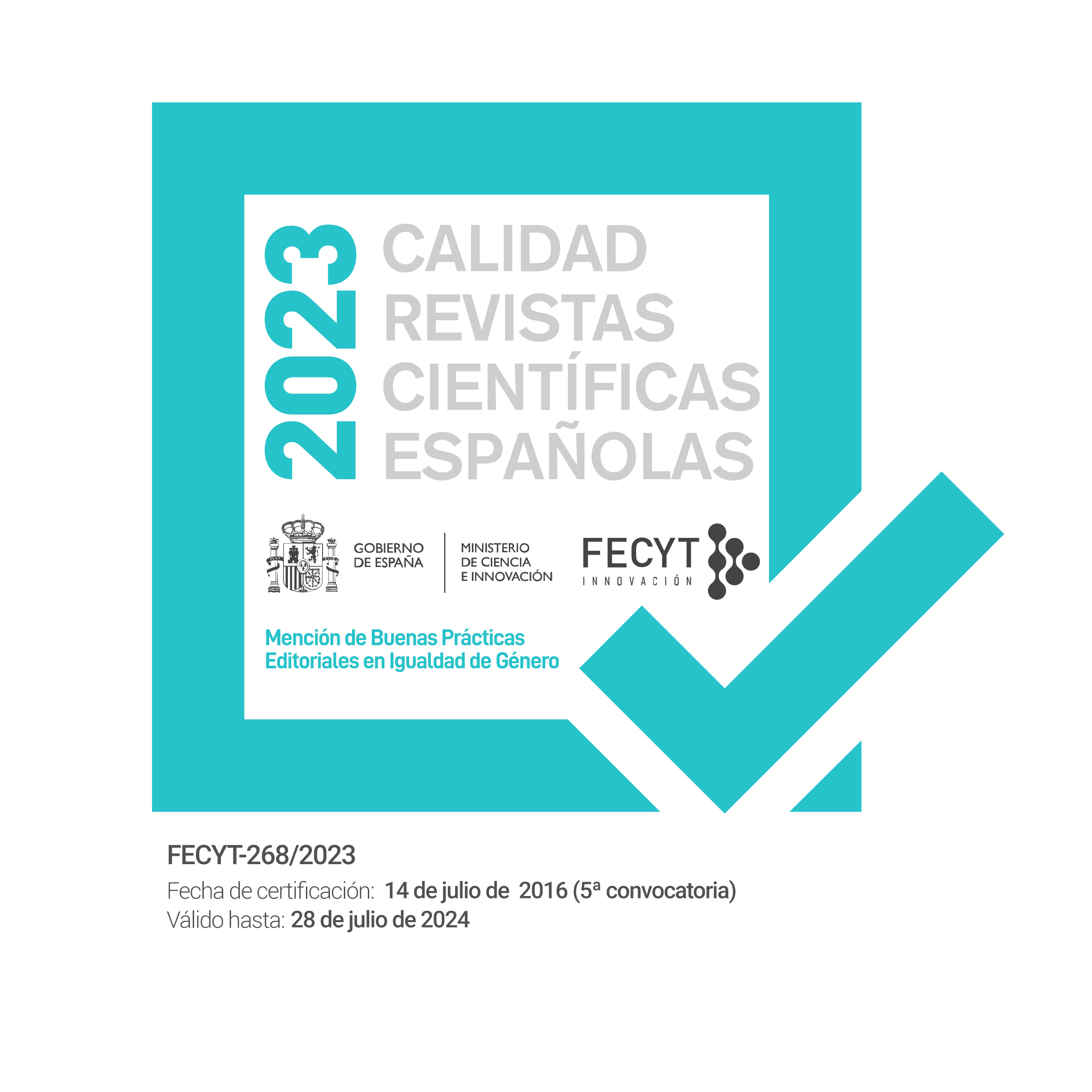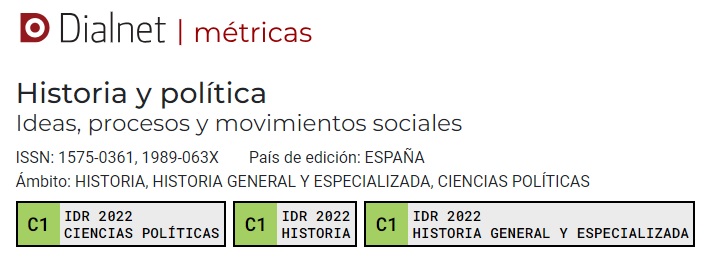Democracy. The political iconography of modern key concepts
DOI:
https://doi.org/10.18042/hp.44.07Abstract
The meanings of some modern political key concepts were set in the social imaginary not only by means of different kinds of texts and of speeches. Images also played a key role in the representation of concepts and were strategically used in the political fights aiming to connote and resignify them. Cartoons are a sort of pictures which became especially important during the historical process when the political iconography of key modern concepts was shaped. Cartoons were widely widespread through the illustrated press that combining graphic humor and political satires had an increasing popularity. The historical making of the meanings of the concepts from a visual narrative that blended ideas and symbols is here illustrated by a case study: democracy. Specifically this article tries to reconstruct the use of images of democracy from the first modern allegories included in the treatises on iconology published in the 17th Century to the World War II. In so doing, particular attention is paid to some historical moments when both the understanding and the meaning of democracy underwent major changes.]
Downloads
References
Album di 32 caricature politiche e di emblemi relativi alla rivoluzione francese in Italia (1799).
Agulhon, Maurice (1981). Marianne into Battle. Republican imagery and Symbolism in France, 1789-1880. Cambridge: Cambridge University Press.
Agulhon, Maurice (2016). Política, imágenes, sociabilidades. De 1789 a 1989. Zaragoza: Prensas Universitarias de Zaragoza.
Benson, Timothy (2008). Low and the Dictators. Londres: The Political Cartoon Society.
Burke, Peter (2001). Eyewitnessing. The Uses of Images as Historical Evidence. Londres: Reaktion Books.
Boudard, Jean-Baptiste (1766) [1759]. Iconologie, tirée de divers auteurs: ouvrage utile aux gens de lettres, aux poëtes, aux artistes, et généralement à tous les amateurs des beaux-arts. Viena: Jean-Thomas de Trattnern.
Capdevila, Jaume (2012). La figura femenina en la prensa satírica española del siglo XIX. Tebeosfera, 9 https://www.tebeosfera.com/documentos/la_figura_femenina_en_la_prensa_satirica_espanola_del_siglo_xix.html
Capellán, Gonzalo (2013): Los ‘momentos conceptuales’. Una nueva herramienta para el estudio de la semántica histórica. En J. Fernández Sebastián y G. Capellán (eds.). Conceptos políticos, historia y tiempo (pp.195-233). Santander: MacGraw-Hill /Ediciones de la Universidad de Cantabria.
Conze, Werner (1993). Prospettive”. En Conza et al. Democrazia. I concetti della política. Venecia: Marsilio.
Curtis, Neil (ed.) (2010). The Pictorial Turn. Londres y Nueva York: Routledge.
Christin, Olivier (1991). Une révolution symbolique: l'iconoclasme huguenot et la reconstruction catholique. París: Minuit.
Christin, Olivier (2003). Les yeux pour le croire. Les Dix Commandements en image (XVe-XVIIe siècles). Paris : Seuil.
Cranach, Lucas (1521). Passional Christi und Antichristi. Wittember.
Fernández Sebastián, Javier y Capellán, Gonzalo (2018): Democracy in Spain: An Ever-Expanding Ideal. En J. Innes y M. Philp (eds.). Re-imagining Democracy in the Mediterranean (pp. 53-74). Oxford: Oxford University Press.
Gombrich, Ernst Hans (1940). Caricature. Londres, The Kin Penguin Books.
Gómez, Silvana A. (2005). Caras y caretas: el semanario como caricatura. Estudios del ISHIR, 12, 23-45.
Gravelot, Hubert-François y Cochin, Charles-Étienne (1791). Iconologie par figures, ou Traité de la science des allégories. París: 4 vols.
Gravelot, Hubert-François y Cochin, Charles-Étienne (1866). Iconología o tratado de alegorías y emblemas. Obra traducida al castellano y anotada por el Lic. Don Luis G. Pastor. Catedrático de Literatura en el Colegio de San Juán de Letrán. México: Imprenta Económica.
Haywood, Ian (2013). Romanticism and Caricature. Cambridge: Cambridge University Press.
Kahn, Michael Alexander y West, Richard Samuel (2014). What Fools these Mortals Be! The Story of Puck. San Diego: IDW Publishing.
Kean, John (2009), The Life and Death of Democracy. New York: Simon & Schuster.
Kerr, David. S. (2000). Caricature and French Political Culture 1830-1848 Charles Philipon and the Illustrated Press. Oxford: Oxford University Press.
Larrère, Mathilde (2018). L´Histoire par Límage
https://www.histoire-image.org/fr/etudes/utopisme-republicain-1848
Mitchell, W.J.T. (1986). Iconology. Image, Text, Ideology. Chicago y Londres: University of Chicago Press.
Mitchell, W.J.T. (1994). Picture Theory. Essays on Verbal and Visual Representation. Chicago y Londres: University of Chicago Press.
Mitchell, W.J.T. (2017). ¿Qué quieren las imágenes? Vitoria-Buenos Aires: Sans Soleil Ediciones.
Oncina, Faustino (2011). El giro icónico en la memoria. El caso de Reinhart Koselleck. En Faustino Oncina y María Elena Cantarino (eds.). Estética de la memoria (pp. 123-148). Valencia: Universitat de València/ Museu Valencià de la Illustració i de la Modernitat.
Palmer, Robert R. (2013), The Age of Democratic Revolution. Princeton: Princeton University Press (1ª ed. 1959).
Pastoreau, Michel (2017). Red. The History of a Color. Princeton University Press / Oxford University Press.
Peyrou, Florencia (2008) Tribunos de la plebe. Demócratas y republicanos durante el reinado de Isabel II. Madrid: CEPC.
Reichardt, Rolf y Kohle, Hubertus (2008). Visualizing the
Revolution. Politics and Pictorial Arts in Late Eighteenth-century France. Londres: Reaktion Books.
Reichardt, Rolf y Lüsebrink, Hans-Jürgen (1997). The Bastille. A history of a Symbol. Duke University Press.
Richter, Melvin (1995). The History of Politial and Social Concepts. An introduction. Oxford: Oxford University Press.
Ripa, Cesare (1987). Iconología. Madrid: Akal, 2 vols.
Sebastián de Castellanos, Basilio (1850). Iconología cristiana y gentilicia. Compendio del sistema alegórico y diccionario manual de la iconología universal. Madrid: Imprenta de E. González.
Seymur-Ure, Colin y Schoff, Jim (1985). David Low. Londres: Secker & Warburg.
Wilson, W.: (1917). Address of the President of the United States Delivered at a Joint Session of the Two Houses of Congress, April 2 1917. Washington: Government Printing Office.
Published
Issue
Section
License
Copyright (c) 2020 Gonzalo Capellan

This work is licensed under a Creative Commons Attribution-NonCommercial-NoDerivatives 4.0 International License.
Authors whose contributions are accepted for publication in this journal, accept the following terms:
a. The authors retain their copyright and guarantee to the magazine the right of first publication of their work, which will be simultaneously subject to the Creative Commons Attribution License Attribution-Noncommercial-No derivative works 4.0 Spain, which allows third parties to share the work as long as its author and its first publication is indicated.
b. Authors may adopt other non-exclusive license agreements to distribute the version of the published work (e.g. deposit in an institutional repository or archive, or published in a monographic volume) provided the initial publication in this journal is indicated.
PLAGIARISM AND SCIENTIFIC FRAUD
The publication of work that infringes on intellectual property rights is the sole responsibility of the authors, including any conflicts that may occur regarding infringement of copyright. This includes, most importantly, conflicts related to the commission of plagiarism and/or scientific fraud.
Plagiarism is understood to include:
1. Presenting the work of others as your own.
2. Adopting words or ideas from other authors without due recognition.
3. Not using quotation marks or another distinctive format to distinguish literal quotations.
4. Giving incorrect information about the true source of a citation.
5. The paraphrasing of a source without mentioning the source.
6. Excessive paraphrasing, even if the source is mentioned.
Practices constituting scientific fraud are as follows:
1. Fabrication, falsification or omission of data and plagiarism.
2. Duplicate publication.
3. Conflicts of authorship.





